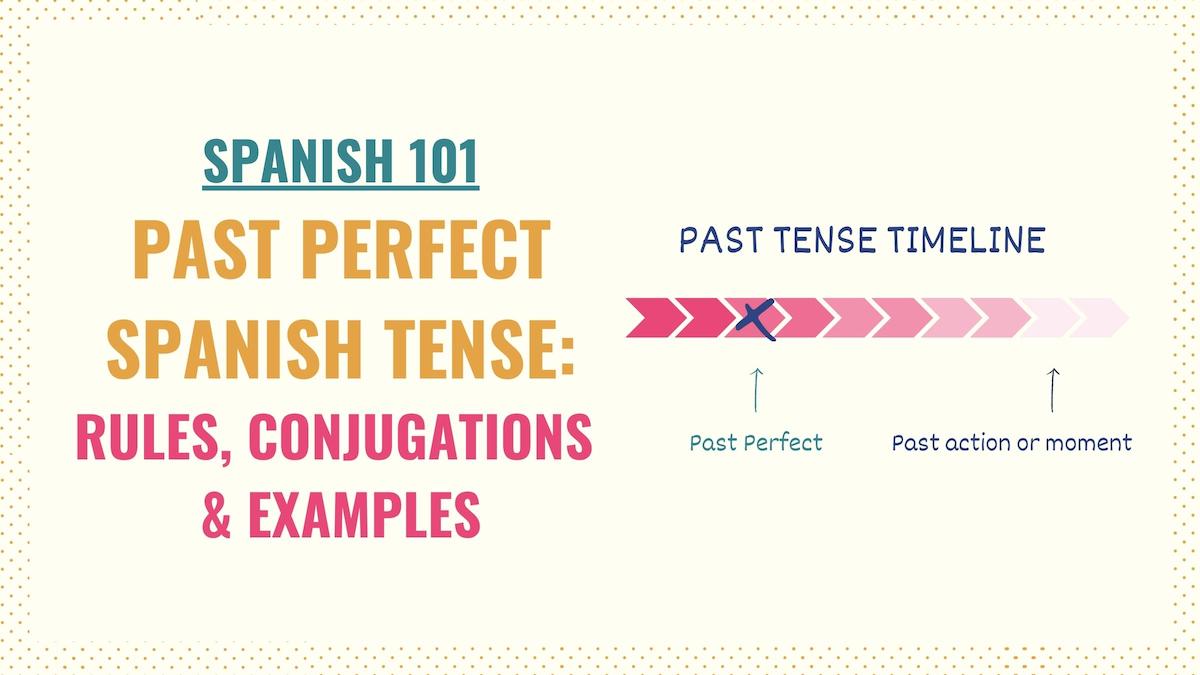When it comes to Spanish past tenses, most learners focus on the preterite and the imperfect indicative tenses. However, the past perfect Spanish tense (also called pluperfect) is also key to talking about past actions and events.
Since the Spanish past perfect indicative tense is a must when referring to past actions, we’ll learn how to form it and when to use this tense in this guide. Here is an overview of what we’ll cover:
- Conjugating to the Past Perfect
- How & When to use the Past Perfect
- Past Perfect vs Present Perfect & Preterite
- Key Points
- Practice Quiz
- Downloadable PDF
How to Conjugate to the Past Perfect in Spanish
In Spanish, the past perfect is a compound tense. In other words, to conjugate this tense, we need two verbs: the auxiliary verb haber and a main verb in past participle form.
This is the formula to conjugate the Spanish past perfect:
[Imperfect forms of haber] + [verb in past participle]
With the past perfect tense, haber expresses when the action happened (the past) and who performed it. Below is a quick reminder of how to conjugate haber to the imperfect tense:
- Yo había
- Tú habías
- Él / Ella / Usted había
- Nosotros habíamos
- Vosotros habíais
- Ellos / Ellas / Ustedes habían
Take Note: Haber imperfect conjugations are the equivalent of had in English. In Spanish, this perfect tense is known as pretérito pluscuamperfecto or, simply, pluscuamperfecto.
To conjugate to the past perfect tense, you must also use a verb in past participle form. This verb refers to the action that had been performed. Regular verbs are transformed into past participles by adding these endings to the stem:
- -ado for -AR verbs
- –ido for -ER and -IR verbs
Check these sentences to see how to conjugate the past perfect of limpiar, leer, venir:
[Haber in the imperfect tense] + [verb in past participle]
Yo ya había limpiado la sala.
I had already cleaned the living room.
¿Nunca habías leído ese libro?
Had you never read that book before?
No habíamos venido porque estábamos enfermos.
We hadn’t come because we were sick.
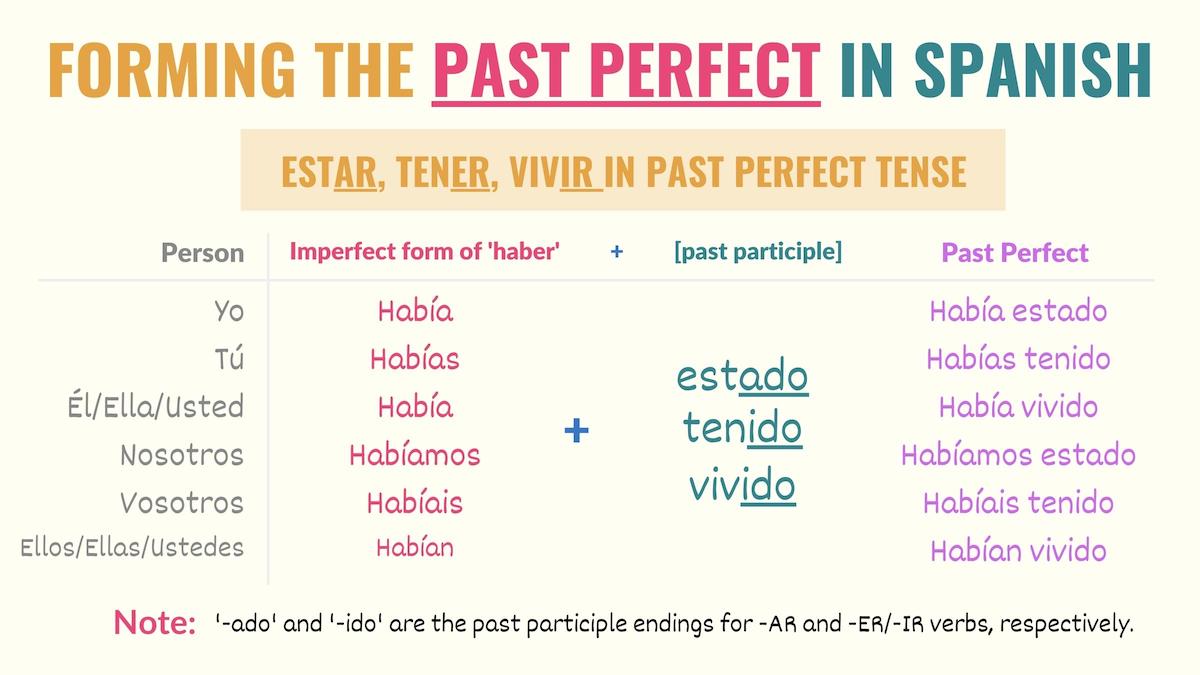
Take Note: Like any other perfect tense, the only irregular verbs in the past perfect tense are the verbs with an irregular past participle form. Decir (dicho), hacer (hecho), morir (muerto), and romper (roto) are examples of irregular past participles in Spanish.
Spanish past perfect for reflexive verbs
Spanish reflexive verbs use the same formula when conjugated to the pluperfect in Spanish. However, you must always place the reflexive pronoun before haber.
Take the reflexive verb despertarse as an example:
[Reflexive pronoun] + [imperfect form of haber] + [past participle]
Cuando entraste, ya me había despertado.
I had already woken up when you entered.
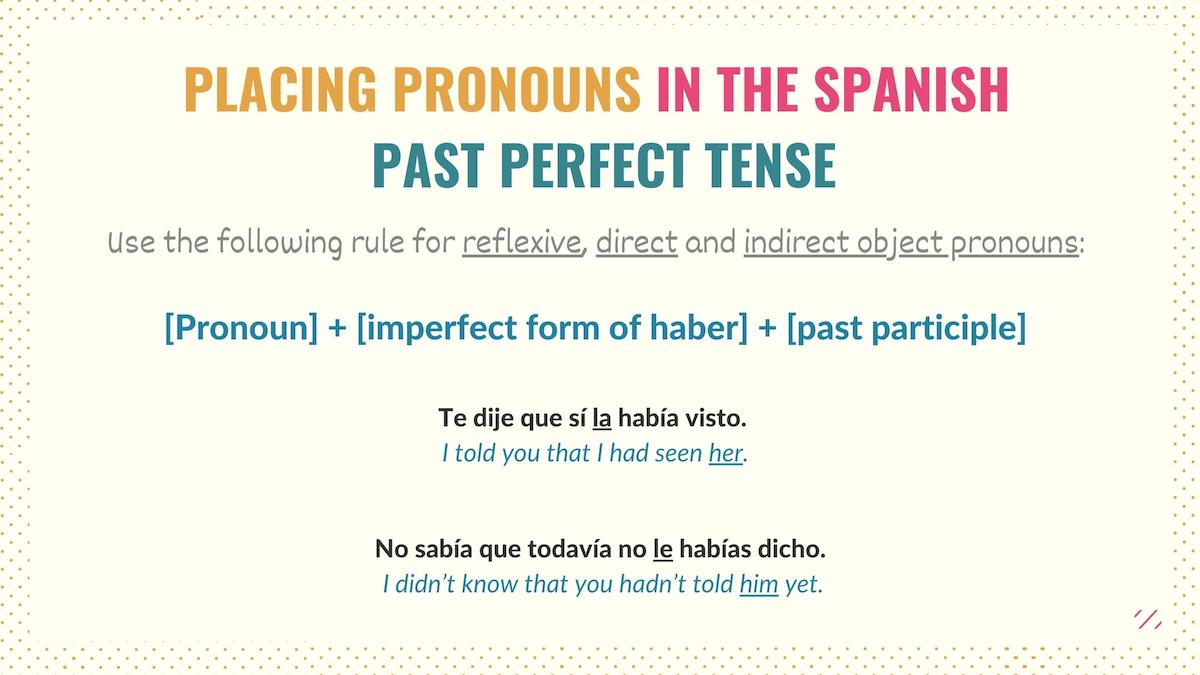
This placement rule is also applied to direct and indirect object pronouns:
[Pronoun] + [imperfect form of haber] + [past participle]
Te dije que sí la había visto.
I told you that I had seen her.
Cuando me dijiste, ya me las había comido.
When you told me, I had already eaten them.
No sabía que todavía no le habías dicho.
I didn’t know that you hadn’t told him yet.
When & How to Use the Past Perfect Tense in Spanish
The past perfect in Spanish refers to a past finished action that happened before another past action or the moment of speaking.
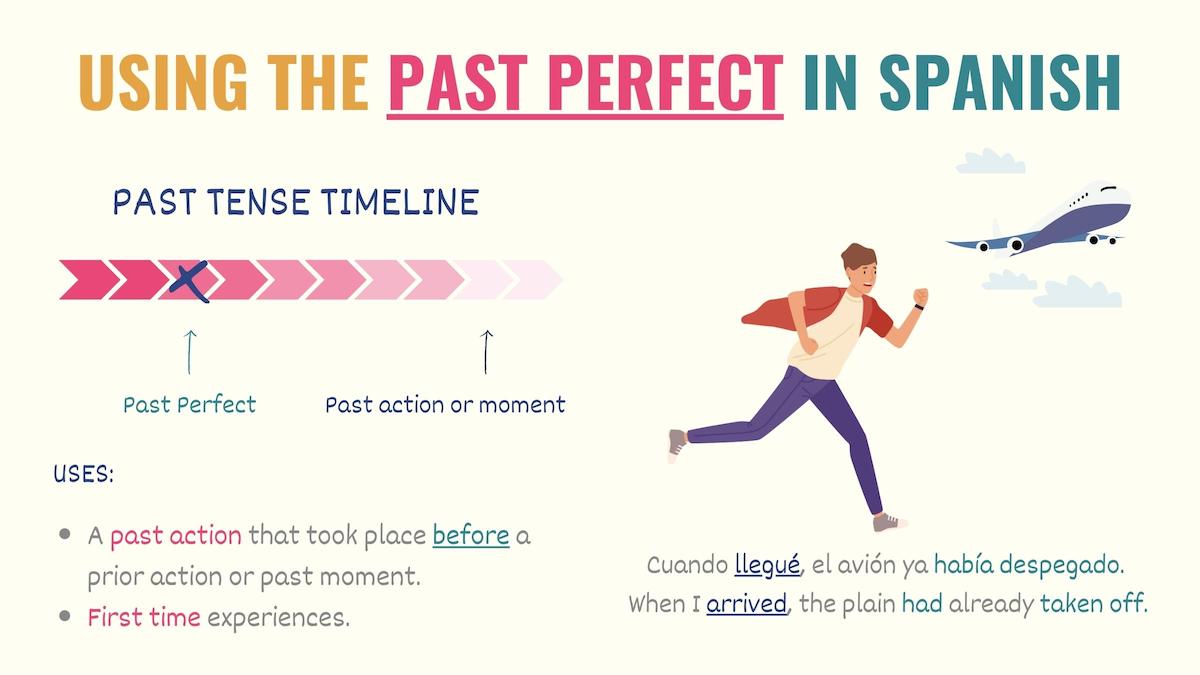
Let me break this theory down into simple real-life applications. You can use the past perfect tense to:
- Talk about first-time experiences (experiences you hadn’t had before now)
- Explain that a past action occurred before another one
Here are some example sentences:
[Auxiliary verb haber] + [verb in past participle]
Perdón, no te había visto.
Sorry I hadn’t seen you.
Nunca había vivido sola.
I had never lived alone.
Nunca había perdido mis llaves.
I had never lost my keys before.
Cuando llegamos, los niños ya se habían dormido.
When we arrived, the kids had already fallen asleep.
Recheck the previous examples again.
The past perfect tense in Spanish conveys that one action happened before something else (another action). For example, the kids went to bed before we got home. Or, before this moment, I had never lost my keys.
Notice that sentences with the past perfect tense may contain a verb in the preterite tense (pretérito). In this case, the past preterite refers to the previous action (like example #3). You can also use dates or adverbs of time (nunca, ya, cuando, todavía, etc) to provide this reference point.
Take Note: Like any other Spanish tense, it’s not mandatory to include a time frame when using the pluperfect.
Difference Between the Past Perfect & Other Tenses
Because they’re both built with the formula haber + past participle verb, this tense is often confused with the present perfect tense. Additionally, because they both refer to past actions which have been completed, people can also confuse the past perfect with the Spanish preterite tense.
Check this graphic below:
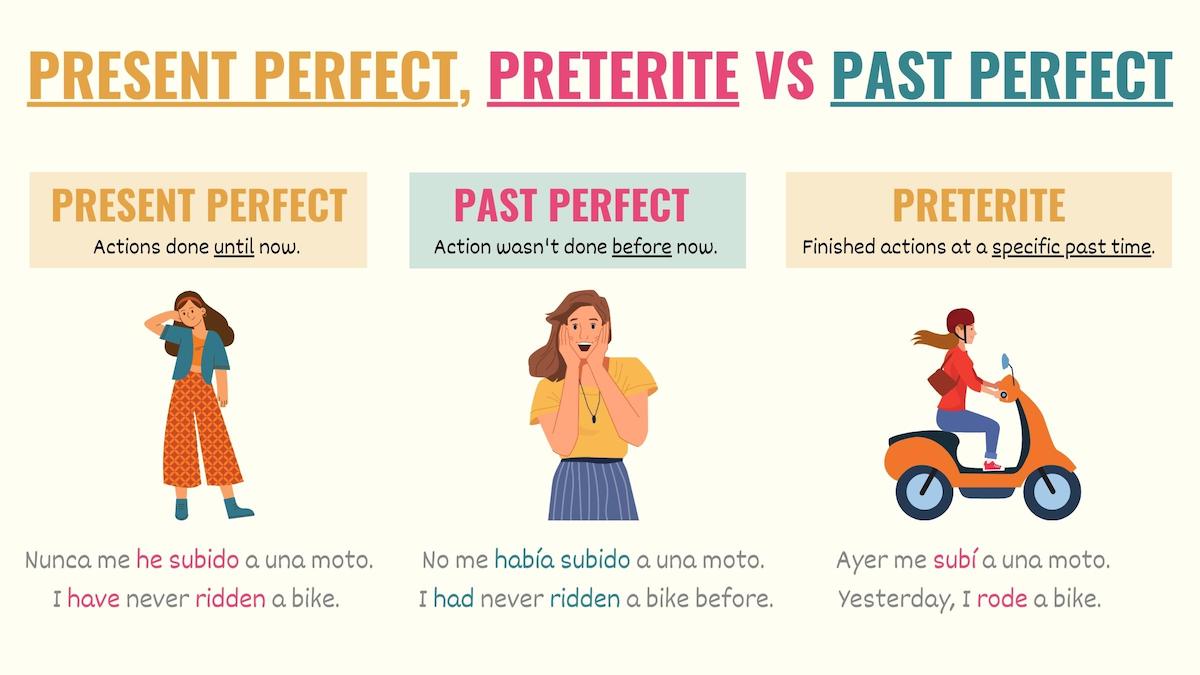
Although they use a similar formula, the Spanish present perfect refers to actions that started at some point in the past but are still applicable to the present (I still have the chance to ride a bike).
On the other hand, the preterite expresses completeness and can point out when that action started or finished. As you’ve learned, the past perfect tense refers to prior actions that happened before something else (like before now).
Key Points
If you want to be able to talk about the past in Spanish, you must understand how to use the past perfect indicative tense. Here are some key points you should know:
- Haber in imperfect form + past participle is the formula to conjugate to the past perfect in Spanish.
- This perfect tense refers to things that happened before a past time frame or a prior action.
- Reflexive, indirect and direct object pronouns must be placed in front of the verb haber.
- A verbs in preterite tense, adverbs of time, or dates can be used in a sentence as reference points.
Spanish Past Perfect Practice Quiz
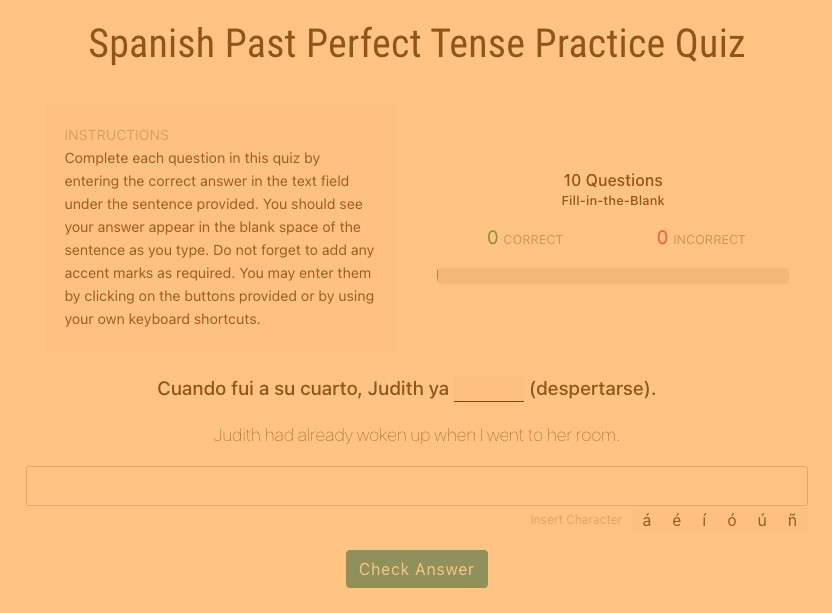
Now that you know how to conjugate and use the Spanish past perfect tense, you should put your knowledge to practice by taking this past perfect quiz.
Download the Past Perfect in Spanish PDF
Spanish grammar topics like the past perfect tense can take time and repetition when it comes to learning all of the rules regarding when to use it and how to conjugate verbs to this past tense. So, I’ve created a free downloadable PDF with the cheat sheets and resources for this guide including the past tense comparison chart and more.

